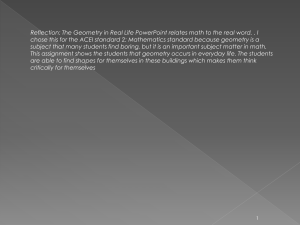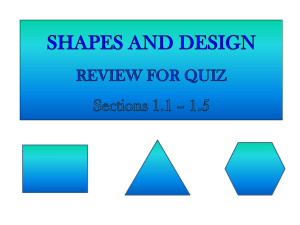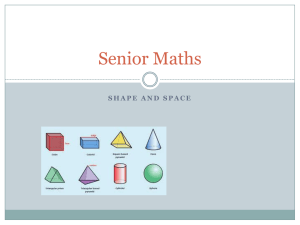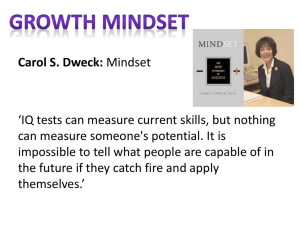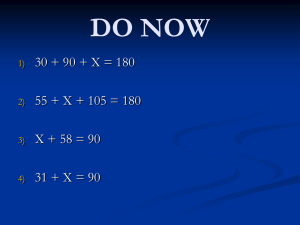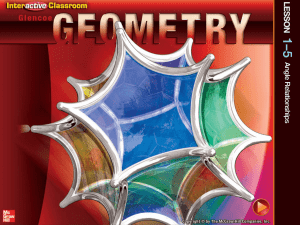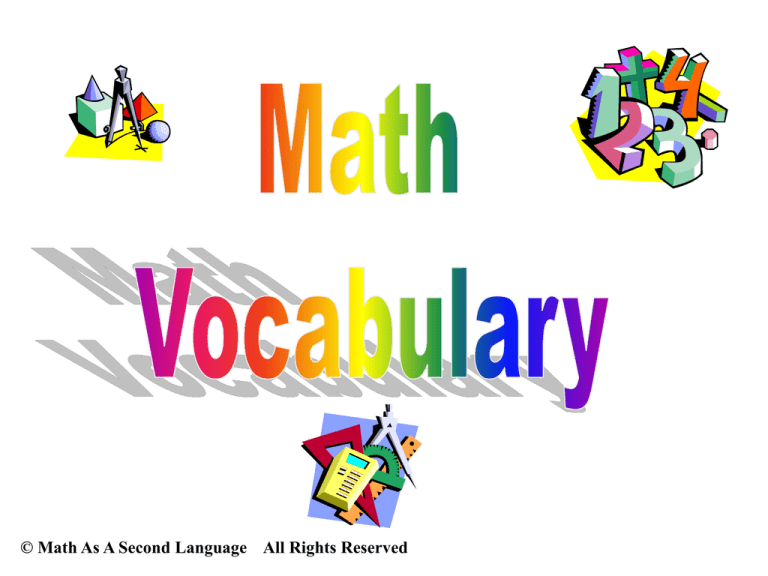
© Math As A Second Language All Rights Reserved
abacus: a frame on which beads
are moved along rods to help count,
add or subtract quickly without
writing.
acre: a measure of land equal to
4,840 square yards, or 43,560 square
feet, or a little less than a football field.
4,840 square yards
acute angle: an angle that
measures less than 90 degrees.
acute triangle: a triangle that
has three acute angles.
addend: a number added to
another number in an addition
problem.
26 + 10 = 36
angle: the space measured in
degrees formed by two rays.
Arabic numerals: first
numbers taught to the Europeans.
1, 2, 3, 4, 5, 6,
7, 8, 9, and 0
arc: a small part or section of a
circle.
area: the amount or size of a surface
usually measured in square units.
16 square
units
average: the answer found by
dividing the sum of a group of numbers
by the number of addends.
92
100
5 460
90
45
95 5 addends
1
0
93
10
82
460
axis: a line that shows the horizontal
or vertical scale of a graph.
y axis
x axis
bar graph: a graph that uses bars
to compare data.
base: the lowest part, the bottom, or
foundation line of a figure.
base
billion: a thousand millions.
1,000,000,000
capacity: the amount a container
can hold.
Celsius: the metric temperature
scale on a thermometer where water
freezes at 0 degrees and boils at 100
degrees.
100 C boiling
0 C freezing
centigram: a metric unit for
measuring mass/ weight. cg
100cg = 1 gram
centiliter: a metric unit for
measuring the amount a container can
hold. cl
100cl = 1 liter
centimeter: a metric unit for
measuring length.
cm
100cm = 1 meter
chord: a straight line segment
joining two points on a curve.
A
Chord AB
B
circle: an unbroken line drawn
around a center point where each point
on the line is the same distance from
the center point.
circle graph: a circle divided
into parts to compare data.
Hockey
12.5%
Basketball
12.5%
Football
25%
Baseball
50%
circumference: the distance
around a circle.
closed figure: a shape or figure
that starts and ends at the same point.
common denominator: a
common multiple of the denominators
of two or more fractions.
1
3
5
6
4
9
multiple of 3
3, 6, 9, 12, 18
multiple of 6
multiple of 9
6, 12, 18
9, 18
6
18
15
18
8
18
common factor: a number that
divides two or more numbers with no
remainder.
greatest common factor
18 {1,
1 2,
2 3,
3 6,
6 9, 18}
1 2,
2 3,
3 4, 6,
6 8,12, 24}
24 {1,
common multiple: a number
(except 0) that is a multiple of two
numbers.
least common multiple
{4, 8, 12, 16, 20, 24}
{6, 12, 18, 24, 30,}
composite numbers: whole
numbers having factors other than one
and itself.
Factors
18
{1, 2, 3, 6, 9, 18}
24 {1, 2, 3, 4, 6, 8,12, 24}
composite function: a
function with two or more operations.
x
x3
n
+5
y
x
+6
n
x4
y
concrete models: a
manipulative or physical
representation.
sphere
circle
symmetry
cone: a solid object that narrows
evenly from a flat, round base at one
end to a point at the other.
congruent: having the same size
and shape.
consecutive: numbers or objects
with a difference of one following one
another in order without a break.
13, 14, 15, 16, 17…
conversions: exchange for an
equivalent value.
96 meters = 9,600 centimeters
30 feet = 10 yards
$10.00 = 100 dimes
4/6 = 2/3
cube: a solid object with six square
faces or sides, all the same size.
cubic unit: a unit used to measure
the volume of a solid object.
5 cubic units
1 cubic foot = 1 foot long,
1 foot wide, and 1 foot high.
cup: a unit for measuring capacity in
the U.S. customary measure.
2 cups = 1 pint
cylinder: a hollow or solid object
shaped like a can with a round top or
bottom of the same size.
data: facts and numbers that
provide information.
2,000,000 people
4,863 feet
25 inch circumference
day: the time it takes the earth to
make one complete turn on its axis.
24 hours
decagon: a polygon or figure with
10 sides and 10 angles.
decimal: based on ten. a fraction
with a denominator of ten or some
power of ten, such as 100.
.6 or 6/10
.06 or 6/100
.006 or 6/1000
decimal point: the point or
period placed in front of a multiple of
ten.
. 657
decimeter: a unit of length in the
metric system.
1 dm = .1 meter
or
10 centimeters
degree: a unit for measuring
temperature and for measuring angles
and curves of a circle, represented by
the symbol.
temperature
A = 89
65
denominator: a bottom number
of a fraction that shows the total
number of equal parts.
1
2
3
3/4
4
diagonal: a straight line that
connects one corner to the opposite
corner of a four sided figure.
difference: the number left after
subtracting one number from another
number.
10 - 4 = 6
10
-4
6
digit: a symbol used to represent the
numbers 0 - 9.
ten digits
0, 1, 2, 3, 4, 5,
6, 7, 8, 9
dividend: the number being
divided in a division problem.
15 7515
divisibility: the state of being
divided.
36 ÷ 6 = 6
divisor: the number that the
dividend is divided by in a division
problem.
15 7515
edge: the line formed where two
sides or faces of a solid meet.
endpoints: points at the opposite
ends of a line segment.
equation: a number sentence in
arithmetic that shows two amounts are
equal.
25 x 10 = 250
equiangular triangle: a
triangle with three equal angles that
each measure 60 degrees.
equilateral triangle: a
triangle with three sides of equal length
and three 60 degree angles.
equivalent fractions:
fractions that equal the same number.
2/5 = 4/10
5/8 = 10/16
estimate: a general but careful
guess about the value, size, quantity, or
cost of something.
even number: a number having
no remainder when divided by two,
ending in 0, 2, 4, 6, 8.
6,581,250
353,196
expanded notation:
a
numeral written in expanded form
using place values.
76, 582 = (7 x 10,000) +
(6 x 1000) + (5 x 100) +
(8 x 10) + (2 x 1)
exponent: a number that shows
how many times a base number is used
as a factor.
4
6 =6x6x6x6
= 1296
expression: a group of numbers
or symbols representing a quantity or
operation.
6X + 15
face: the flat surface of a solid
object.
factor: a number being multiplied
to obtain an answer or product.
6 X 9 = 54
Fahrenheit: the
temperature
scale on a thermometer where water
freezes at 32 degrees and boils at 212
212 F boiling
degrees.
32 F freezing
figure: an object that has shape,
outline or form.
fluid ounce: a liquid unit for
measuring capacity in the U.S.
Customary System.
8 fl oz = 1 cup
foot: a unit of length in the U.S.
Customary System.
1 ft = 12 inches
fraction: one or more of the equal
parts into which a whole number is
divided.
1/2
3/5
function machine: a device
which allows you to put numbers in
and get numbers out according to an
arithmetic rule.
x24
8
gallon: a unit for measuring liquids
in the U.S. Customary System.
1 gal = 4 quarts
geometry: the part of
mathematics that deals with and
measures lines, angles planes, and solid
figures.
grams: a metric unit for measuring
weight or mass. g
1000g = 1 kilogram
graphs: 1. diagrams that show
relationships between variables.
T
e
m
p
e
r
a
t
u
r
e
Days of the Week
graphs: 2. the collection of all
points whose coordinates satisfy a
given function.
x=y
(5,5)
(4,4)
(3,3)
(2,2)
(1,1)
(0,0)
greater than: a term used to
compare numbers.
16 13
grid: a pattern of evenly spaced
vertical and horizontal lines that form
squares, used for locating points on a
map or chart.
gross: a group of 12 dozen, or 144
items.
hexagon: a polygon or figure with
six sides and six angles.
heptagon: a polygon or figure
with seven sides and seven angles.
hundredth: one of 100 equal
parts written as 1/100 or .01.
.16 = 16 hundredths
inch: a unit of length in the U.S.
Customary System.
input-output: an independent
variable put in produces a dependent
variable coming out.
input x
+9
y output
input 5
+9
14 output
input 7
+9
16 output
integers: all the positive and
negative whole numbers including 0.
0, 1, 2, 3, 4, 5 …
-1, -2, -3, -4, -5 …
interior angles: are the inside
angles of a polygon whose sides
intersect at the vertex.
intersection: where two lines
meet or cross.
isosceles triangle: a triangle
with two congruent sides and two
congruent angles.
kilogram: a metric unit for
measuring weight or mass. kg
1000g = 1 kg
kiloliter: a metric unit for
measuring capacity. kl
1000 liters = 1 kl
kilometer: a metric unit for
measuring length. km
1000 meters = 1 km
kite: a four-sided figure with two
pairs of adjacent sides equal.
less than: a term used to compare
numbers.
16
19
line: a path along a set of points that
extends in both directions indefinitely.
line
line graph: a graph that uses a
line to show changes over a period of
time.
line plot: a line used to plot or
place numbers.
X
X
X
X
1
2
X
X
-2
-1
0
line segment: part of a line with
two endpoints.
line segment
liter: a metric unit for measuring
capacity. l
1000 milliliters = 1 l
or a little less than
a quart
mean: the answer found by dividing
the sum of a group of numbers by the
number of addends. Average.
92
100
5 460
90
45
95 5 addends
1
0
93
10
82
460
median: the middle number in a
set of numbers after they have been
arranged highest to lowest.
65, 60, 58
58, 55, 50
meter: a metric unit for measuring
length. m
100 centimeters = 1m
or 39.37 inches
metric system: a system of
weights and measures based on tens,
hundreds, and thousands.
grams
liters
meters
mile: a unit of length in the U.S.
Customary System.
1 mile = 5,280 ft
milligram: a metric unit for
measuring weight or mass. mg
1000 mg = 1 gram
milliliter: a metric unit for
measuring capacity. ml
1000 ml = 1 liter
millimeter: a metric unit for
measuring weight or mass. mm
1000 mm = 1 meter
minuend: a number from which
another number is subtracted.
6, 8 9 0, 8 7 5
- 3, 2 3 6, 7 9 8
3, 6 5 4, 0 7 7
mixed number: a number that
contains a whole number and a
fraction.
5 1/2
multiple: the product of a given
number and any whole number.
multiple of two
2, 4, 6, 8, 10…
multiplication: the process of
repeated addition.
3 x 5 = 15
5 + 5 + 5 = 15
negative integer: an amount or
number less than zero written with the
symbol (-).
-14
-45
-28
nonagon: a polygon or figure with
9 sides and 9 angles.
numerator: the number above
the line in a fraction that shows the
number of parts chosen.
8
9
obtuse angle: an angle that
measures more than 90 degrees and
less than 180.
obtuse triangle: a triangle with
one obtuse angle.
octagon: a polygon or figure with 8
sides and 8 angles.
odd number: a number having a
remainder when divided by two,
ending in 1, 3, 5, 7, 9.
6,581,257
353,193
open figure: a shape or figure
whose outside lines do not come
together and close the figure or shape.
ordered pair: a pair of numbers
that show a location on a grid.
0
3,2
order of operations: rules to
follow: 1. Do what is in parenthesis
first. 2. Do exponents next. 3. Multiply
and divide from left to right. 4. Add
and subtract from left to right.
2
(2 + 4) x 4 ÷ 2 + 6 - 5 = b
2
(6) x 4 ÷ 2 + 6 - 5 = b
(36) x 4 ÷ 2 + 6 - 5 = b
144 ÷ 2 + 6 - 5 = b
72 + 6 - 5 = b
78 - 5 = b
b = 73
ounce: a unit of measuring weight
in the U.S. Customary System.
16 oz = 1 pound
parallel lines: lines that are
always the same distance apart and
never intersect.
parallelogram: a four sided
figure with opposite sides parallel and
of equal length.
pentagon: a polygon or figure
with five sides and five angles.
percent: a quantity measured by
the number of units compared with 100
represented by the symbol %.
96
100 = .96 = 96%
perimeter: the distance around a
polygon or figure.
pentagon: a polygon or figure
with five sides and five angles.
perpendicular lines: two
lines that intersect and form right
angles.
pi: the ratio of the circumference to
the diameter of any circle.
3.14
π
pint: a unit of measuring liquids in
the U.S. Customary System.
1 pt = 2 cups
plane: a flat level surface extending
in all directions.
place value: a value assigned to a
position in a number.
5,327,689
point: an exact location in space
usually labeled with a letter.
A
polygon: a closed, flat shape or
figure formed by line segments.
positive integer: an amount or
number greater than zero.
+14
+45
+28
pound: a unit of measuring weight
in the U.S. Customary System.
1 lb = 16 oz
prediction: a guess about a future
event based on mathematical or
scientific facts.
Solar Eclipse
prime numbers: numbers that
only have itself and one as factors
(starting with 2).
2=2x1
3=3x1
5=5x1
{2, 3, 5, 7, 11, 13, 17…}
prime factorization: a
process used to find all prime factors of
a number.
24
6
Prime
x
4
2 x 3x2 x2
Factors
prism: a solid object with two ends
that are equal and parallel and sides
that are parallel.
probability: a mathematical
basis for prediction. How often an
event happens.
How often can you flip a coin and get
heads? One out of two chances, 1/2 ,
.50, or 50%.
product: the answer in a
multiplication problem.
6 X 9 = 54
properties / attributes: a
quality or trait belonging to a specific
thing.
Four equal sides
Four right angles (90º)
Opposite sides parallel
Sum of interior angles
equals 360º.
proportion: 1. The relation of one
part to another or to a whole.
2. A relation of equality of two ratios.
3
9
=
4 12
protractor: a tool shaped like
half of a circle marked off in degrees
used to draw measured angles.
pyramid: a solid figure or object
with a flat base and three or more
sloping sides that are triangles that
come together in a point at the top.
quadrilateral: a polygon or
object with four sides and four angles.
quart: a
unit for measuring
capacity in the U.S. customary system.
1 qt =2 pints or ¼ gallon.
quotient: the answer in a division
problem.
503
15 7515
radius: a straight line from the
center to a point on the outside of a
circle or sphere.
radius
range: the difference between the
greatest and the least numbers of a
given set or group.
98, 87, 85, 76, 65, 60
98 highest number
- 60 lowest number
38 range
rate: an amount, pace or degree of
something expressed in specific units. A
jet flew at a rate of 200 miles per hour.
rate = distance
time
ratio: the relationship or
comparison between the number or
quantity of two different things.
If there are 9 apples and 3 oranges, the
ratio of apples to oranges is 3 to 1.
9:3
or
3:1
ray: part of a line with only one
endpoint and the other end going on
indefinitely in one direction.
ray
rectangle: a flat figure with four
sides and four right angles but does not
form a square.
reflection: a change in the location
of a figure in which it is flipped over a
line or point.
regular polygon: a
figure or
object in which all sides and all angles
are equal.
remainder: 1. The amount left
after a division problem is complete.
503 r 2
15 7517
remainder:
2. The amount left
over after one number is subtracted
from another.
In 9 - 5 = 4,
4 is the remainder.
rhombus: a flat figure with all
sides equal, but usually no 90 degree
angles.
right angle: an angle that
measures 90 degrees and is formed by
two perpendicular lines.
right triangle: a triangle that
has one 90 degree or right angle.
Roman numeral: letters in the
Roman alphabet that are used as
numbers.
I=1,
V=5,
X=10,
MCCLXVI = 1266
L=50,
C=100,
D=500,
M=1000.
rotations (turns): the act of
turning about an axis or center.
round: changing a number to the
nearest ten, hundred, thousand and so
on, to make it easier to use.
30 can be a
rounded number
for 25 through 34.
scale: 1. Series of regularly spaced
marks along a line.
1
2
3
ruler
4
5
6
scale: 2. The size of a picture, plan
or model in proportion to the actual
size of the thing itself.
scaled size 1:28
scale: 3. A tool or device used to
weigh something.
scalene triangle: a triangle
with no two sides having the same
length.
scientific notation:
a
numeral written in expanded form
using exponents.
4
76, 582 = (7 x 10 ) +
(6 x 10 ) + (5 x 10 ) +
0
1
(8 x 10 ) + (2 x 10 )
3
2
sequence: a set of things whose
order is determined a pattern or rule.
The days of the week are in a sequence.
Monday, Tuesday, Wednesday,
Thursday, Friday, Saturday, Sunday
Numbers can be in a sequence.
one, two, three, four, five, six, seven,
eight, nine, ten
set: a group or collection of numbers
or objects.
2, 4, 6, and 8 are a set of
even numbers.
2, 3, 5, 7, 11, and 13 are
a set of prime numbers.
side: one of the lines or surfaces that
form a figure or object, usually not the
top or bottom.
side
side
simplify: to make simple or reduce
to basic essentials.
8
1
=
16
2
10x + 20 = 10(x + 2)
solid: anything that has length,
width, and height. A cube or sphere is a
solid.
speed: is the rate of motion;
distance over time.
100mph
40mph
sphere: a solid round figure or
object with a surface the same distance
from its center at all points.
A ball, a globe, or the moon are
examples of a sphere.
square: a polygon with four equal
sides and four right angles.
square root: a number obtained
by dividing a number into two equal
factors.
The square root of 9 is 3. (3 x 3 = 9)
The square root of 25 is 5. (5 x 5 = 9)
stem-and-leaf plots:a
technique for ordering data in
increasing or decreasing order.
25, 28, 32, 36, 39, 41, 45
Stem
Leaf
2
3
4
5 8
2 6 9
1 5
straight angle:
an angle that
measures 180 degrees or a straight line.
180 degrees
straight angle
subtrahend: a number that is
subtracted from another number.
6, 8 9 0, 8 7 5
- 3, 2 3 6, 7 9 8
3, 6 5 4, 0 7 7
sum:
the answer in an addition
problem.
4,365
3,786
+ 9,456
17,607 sum
surface area: the sum of the area
of plane surfaces that make up a three
dimensional figure.
6(l x w)= surface area
symmetry:
a figure or object
that has matching parts on both sides
of its center line.
table: a systematic arrangement of
data usually in rows or columns for
easy reference.
Team
Wins
Losses
Red Sox
60
20
Yankees
40
40
Tigers
30
50
Orioles
20
60
A’s
10
70
tenth:
one of 10 equal parts.
In the decimal 0.26, the 2 is in
the tenths place.
tessellations: a careful
positioning of elements into a coherent
pattern.
thousandth: one of 1000 equal
parts.
In the decimal 0.264, the 4 is
in the thousandths’ place.
three dimensional: an object
having length, width, and height.
height
width
length
ton:
a unit for measuring weight or
mass in the U.S. Customary System.
1 ton = 2,000 pounds.
transformation: a change
made to the size or position of a figure.
translations (slides): a
change in the location of a figure in
which it is slid up or down, left or right
without being turned.
trapezoid:
a polygon with four
sides. Two of the sides are parallel.
triangle: a polygon with three
sides and three angles.
two dimensional: a flat surface
with a length and width.
Length
W
i
d
t
h
values:
numerical quantities
assigned or computed.
0 has no value.
The value of 206 + 404 is 610.
variable:
a letter or symbol that
holds a place for a number.
X + 20 = 65
Y + 35 = 65
X + Y = 75
vertex:
the endpoint of two lines or
the point where three or more edges of
a solid figure meet.
vertex
volume:
the amount of space
inside something that has length,
width, and height, measured in cubic
units.
3 in. x 3 in. 3 in.
3 inches
27 cubic inches
3 inches
3 inches
whole number:
a number that
is not a fraction.
75
135
5½
79.8
3,678
75 ½
Yard (yd.):
a unit of length in the
U.S. Customary System.
1 yd. = 3 feet or 36 inches
Year (yr.):
the time it takes the
Earth to revolve around the sun one
time, about 365 days.
365 days
Zero:
1. The number or symbol 0
that means having no quantity.
2. A point marked 0, from which
something is measured.
0


